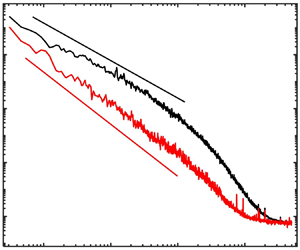No CrossRef data available.
Published online by Cambridge University Press: 25 November 2024

The seminal Bolgiano–Obukhov (BO) theory established the fundamental framework for turbulent mixing and energy transfer in stably stratified fluids. However, the presence of BO scalings remains debatable despite their being observed in stably stratified atmospheric layers and convective turbulence. In this study, we performed precise temperature measurements with 51 high-resolution loggers above the seafloor for 46 h on the continental shelf of the northern South China Sea. The temperature observation exhibits three layers with increasing distance from the seafloor: the bottom mixed layer (BML), the mixing zone and the internal wave zone. A BO-like scaling  $\alpha =-1.34\pm 0.10$ is observed in the temperature spectrum when the BML is in a weakly stable stratified (
$\alpha =-1.34\pm 0.10$ is observed in the temperature spectrum when the BML is in a weakly stable stratified ( $N\sim 0.0018$ rad s
$N\sim 0.0018$ rad s $^{-1}$) and strongly sheared (
$^{-1}$) and strongly sheared ( $Ri\sim 0.0027$) condition, whereas in the unstably stratified convective turbulence of the BML, the scaling
$Ri\sim 0.0027$) condition, whereas in the unstably stratified convective turbulence of the BML, the scaling  $\alpha =-1.76\pm 0.10$ clearly deviated from the BO theory but approached the classical
$\alpha =-1.76\pm 0.10$ clearly deviated from the BO theory but approached the classical  $-$5/3 scaling in isotropic turbulence. This suggests that the convective turbulence is not the promise of BO scaling. In the mixing zone, where internal waves alternately interact with the BML, the scaling follows the Kolmogorov scaling. In the internal wave zone, the scaling
$-$5/3 scaling in isotropic turbulence. This suggests that the convective turbulence is not the promise of BO scaling. In the mixing zone, where internal waves alternately interact with the BML, the scaling follows the Kolmogorov scaling. In the internal wave zone, the scaling  $\alpha =-2.12 \pm 0.15$ is observed in the turbulence range and possible mechanisms are provided.
$\alpha =-2.12 \pm 0.15$ is observed in the turbulence range and possible mechanisms are provided.